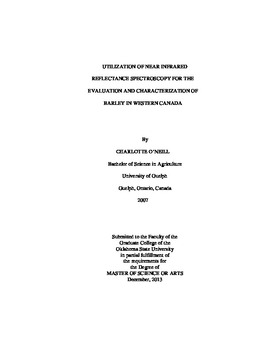| dc.contributor.advisor | Krehbiel, Clinton | |
| dc.contributor.author | O'Neill, Charlotte Faye | |
| dc.date.accessioned | 2015-06-17T20:07:21Z | |
| dc.date.available | 2015-06-17T20:07:21Z | |
| dc.date.issued | 2013-12-01 | |
| dc.identifier.uri | https://hdl.handle.net/11244/15048 | |
| dc.description.abstract | The first study evaluated near infrared reflectance spectroscopy (NIRS) for the determination of barley silage DM on as-is samples using either a commodity specific or broad based equation. A second study was conducted to evaluate a commercial NIRS prediction equation for barley grain, examining the nutrients of DM, CP and starch. Barley samples were selected as HIGH, MID or LOW for each nutrient group and the equation was tested using all samples or only the selected samples. Finally, a third study was conducted to evaluate NIRS as a selection tool for barley grain and the relationship between nutrient composition and digestion kinetics. The results of the first study indicated that NIRS accurately predicts the DM of as-is barley silage (R2 = 0.98, p < 0.05) using either a commodity specific or broad based equation. The second experiment indicates NIRS can accurately predict the DM and CP (R2 > 0.50, p < 0.05), however did not accurately predict starch content of barley grain (R2 �� 0.21, p < 0.05). The third experiment indicates that NIRS holds promise as a selection tool for barley grain quality and a relationship exists being nutrient content and digestion kinetics. There was a significant relationship between the DM content of the sample and the rate of fermentation with LOW DM samples having a faster rate of fermentation than the MID and HIGH (p < 0.05). Gas production of LOW DM samples was greater between 8 and 23 hours of incubation compared to the HIGH and MID (p < 0.05). The MID CP had greater gas production (mL/g of substrate DM, p �� 0.05) than the HIGH range, with LOW being intermediate. Correlations between the NIRS and lab determined chemical constituents and the gas production kinetics were examined. DM was negatively correlated (p �� 0.05) with k and lag when measured with NIRS or in a lab, and CP was significantly (p �� 0.05) negatively correlated with cumulative gas production (NIRS r = -0.31, lab r = -0.31), k (NIRS r = 0.48, lab r = 0.47), and lag (NIRS r = 0.30, lab r = 0.37). | |
| dc.format | application/pdf | |
| dc.language | en_US | |
| dc.publisher | Oklahoma State University | |
| dc.rights | Copyright is held by the author who has granted the Oklahoma State University Library the non-exclusive right to share this material in its institutional repository. Contact Digital Library Services at lib-dls@okstate.edu or 405-744-9161 for the permission policy on the use, reproduction or distribution of this material. | |
| dc.title | Utilization of near Infrared Reflectance Spectroscopy for the Evaluation and Characterization of Barley in Western Canada | |
| dc.type | text | |
| dc.contributor.committeeMember | Step, D. L. | |
| dc.contributor.committeeMember | Lalman, David | |
| osu.filename | ONeill_okstate_0664M_13128.pdf | |
| osu.accesstype | Open Access | |
| dc.description.department | Animal Science | |
| dc.type.genre | Thesis | |
| dc.subject.keywords | barley | |
| dc.subject.keywords | cattle | |
| dc.subject.keywords | near infrared reflectance spectroscopy | |
| dc.subject.keywords | nirs | |
